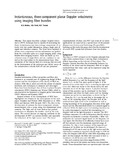- CERES Home
- →
- School of Engineering (SoE)
- →
- Staff publications (SoE)
- →
- View Item
JavaScript is disabled for your browser. Some features of this site may not work without it.
| dc.contributor.author | Nobes, David S. | - |
| dc.contributor.author | Ford, Helen D. | - |
| dc.contributor.author | Tatam, Ralph P. | - |
| dc.date.accessioned | 2011-02-07T23:06:47Z | |
| dc.date.available | 2011-02-07T23:06:47Z | |
| dc.date.issued | 2004-01-01T00:00:00Z | - |
| dc.identifier.citation | D.S. Nobes, H.D. Ford, R.P. Tatam. Instantaneous, three-component planar Doppler velocimetry using imaging fibre bundles, Experiments in Fluids, Volume 36, Issue 1, pp. 3-10 (2004). | en_UK |
| dc.identifier.issn | 0723-4864 | - |
| dc.identifier.uri | http://dx.doi.org/10.1007/s00348-003-0586-0 | - |
| dc.identifier.uri | http://dspace.lib.cranfield.ac.uk/handle/1826/1129 | |
| dc.description.abstract | Abstract This paper describes a planar Doppler velocimetry (PDV) technique that is capable of measuring the three, instantaneous and time average components of velocity over two spatial dimensions using a single pair of signal and reference cameras. The three views required to obtain three-component velocity information are guided from the collection optics to a single imaging plane using flexible fibre imaging bundles. These are made up of a coherent array of single fibres and are combined at one end as the input plane to the measurement head. Measurements of the velocity field of a rotating disk are used in the development of the technique and initial results of the instantaneous velocity field of a jet are presented. | en_UK |
| dc.language.iso | en_UK | en_UK |
| dc.publisher | Springer Science Business Media | en_UK |
| dc.title | Instantaneous, three-component planar Doppler velocimetry using imaging fibre bundles | en_UK |
| dc.type | Article | en_UK |
Files in this item
This item appears in the following Collection(s)
-
Staff publications (SoE) [603]
